2 Domestication of Farm Animals
This
chapter
contains lots of quantitative data - such as carcass weights and
dressing percentages. They give you an idea of the sizes
involved. It is worth remembering the approximations but not the
details. The details change with different sources.
2.1 Origins of beef
Beef - more than one species. In the
developed countries,
beef is mostly produced from cattle of the genus Bos. However, there are several other genera
which will interbreed with Bos to produce fertile, beefy
offspring: Bison; Poephagus,
the yak; Bibos, the
gaurs; Bubalus, the Indian buffalo; Sunda; and Syncerus,
the African buffalo.
In Canada, our interest is in the main evolutionary
steps from Bos primigenius (wild
cattle of ancient Europe, now extinct), to Bos longifrons (the first
domesticated cattle leaving fossils found in archaeological
excavations), to Bos taurus
(modern cattle).
In the tropics, there may have been another sequence, from Bos nomadicus (wild
ancestors) to Bos
indicus (current heat-resistant cattle). B.
indicus,
which may have been derived from B. nomadicus, is now
recognized by the
following features: a prominent shoulder hump of muscle supported by
dorsal
spines of the vertebrae, a long face with drooping ears, upright horns,
small
brow ridges, a prominent dewlap, slender legs, and uniform colouration
(white,
grey or black).
Sketch
of Bos primigenius - the
Aurochs (plural aurochsen) - a butcher's nightmare - vicious horns and
tough meat.
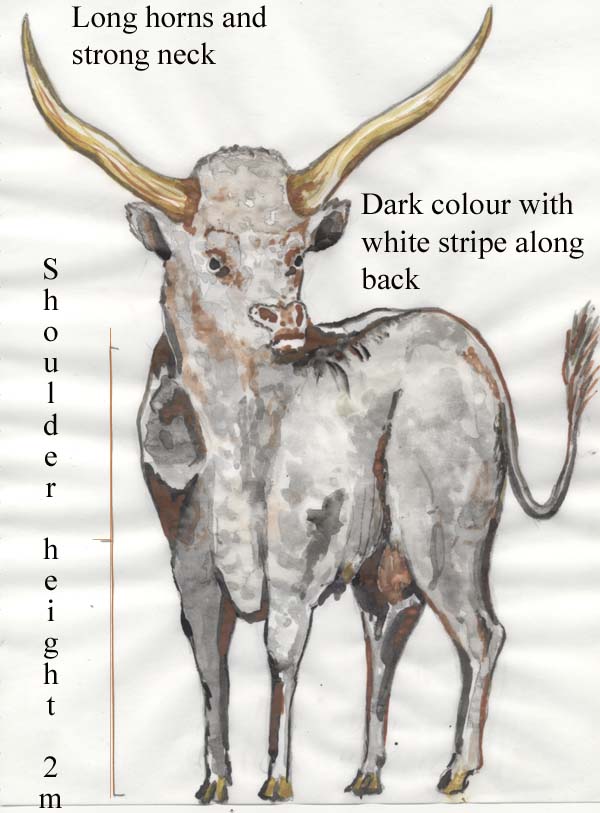
Migrations and mixing. In North America, cattle
were introduced by
Spanish settlers to the Southwest USA, giving rise to breeds such as
the Texas
Longhorn. But in the north, the cattle
were mainly derived from primitive breeds brought by French and British
settlers. Bos primigenius
genes were probably carried by the Spanish cattle while the primitive
northern
breeds were probably a mixture of B. primigenius and B.
longifrons. In early settlements,
the primary importance
of cattle was their ability to pull a plough or a cart, and they were
not
normally slaughtered until the end of their working life. Improved
British
breeds of cattle developed in the late 1700s and 1800s were imported
into North
America to form the basic Shorthorn, Angus, and Hereford stock. Between 1905 and 1920, Bos indicus
(Brahman cattle from India) was introduced into the southern USA for
its
heat tolerance. The most recent phase
of beef breed development in North America has been a re-introduction
of
Continental European beef breeds with rapid early growth and a large
mature
frame size - animals preserved as draft animals where steam engines
were
scarce. The large size of some of these breeds suggests they may
contain
genes derived from Bos primigenius. There is renewed
interest in
early maturing breeds, such as Angus, because of their ability to
produce
fine-grained, tender beef. Whether or
not these features will survive the current selection practices in
favour of
rapid early growth and a large mature frame remains to be seen.
Bison. The
bison (Bison bison), known as
the buffalo in American folklore, was nearly hunted to extinction but
now is
protected and ranched. Ranch bison is sold commercially. The
traditional prime
parts were the tongue and the hump, but steaks and burgers are now the
main
commodity. Bulls can reach a
massive size, around 1,000 kg live weight, but
commercial meat is from smaller animals.
After being on a finishing ration to a slaughter age of 14 to 15
months,
carcasses weigh around 276 and 248 kg for bulls and cows, respectively.
Dressing percentages (defined in LAB 1) are about 60%, but the
carcasses are light in the
hindquarter. Bison meat is dark, but this does not show after cooking.
Treating
bison carcasses like those of beef animals, cooler shrink losses are
slightly
higher than those for beef, probably because of the lighter fat cover
and
larger area of exposed muscles. However, shrink losses from bison
carcasses may
be improved by blast cooling. The saleable yield of meat trimmed to
retail
standards is around 78% of cold carcass weight. Shear values measuring
the toughness of the meat tend
to have a wider range than those of beef but may be generally improved
by
electrical stimulation (which prevents cold-shortening, defined in LEC
13). The ultimate pH (defined in LEC 12) of bison meat is within a
typical range
for red meat (say pH 5.4 to 5.7). The main marketing feature of bison
meat is
that it tends to have a lower fat content than beef.
Buffalo. African buffalo (Syncerus
caffer) come in several
sizes, ranging from the dwarf forest buffalo of
West and Central Africa to the
heavy Cape buffalo of South Africa. For bulls
and cows, respectively, carcass weights of 380 and 326 kg have been
recorded,
with dressing percentages up to about 50%.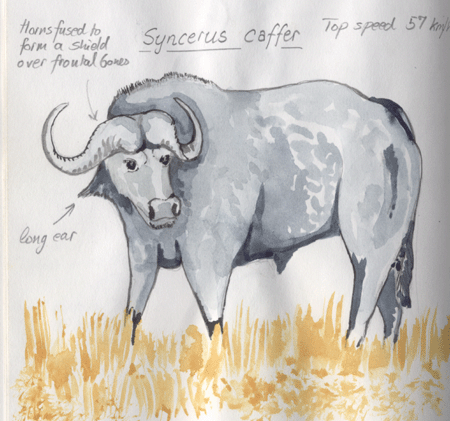
Yak. The domesticated yak of China
and Mongolia is Poephagus (also known as Bos grunniens).
The wild yak
may be called Bos mutus. The domesticated yak of Asia is smaller
(maximum around 550 kg live weight for bulls and 350 kg for cows) than
the wild
yak. Yak hair is long and shaggy and is underlain by fine wool. The
tail is a
long brush, which is unusual for bovines. Yak meat is of secondary
importance.
Milk and hide products are more important.
2.2 Origins of pork
Species of pigs. Fossil pig skeletons have been
found in geological deposits dating back to the Pliocene period in
Europe and
Asia. Domestic pigs of Europe and North
America appear to be a mixture of two original species of wild pig: Sus
scrofa,
the wild boar of Europe found north of the Alps, and S. vittatus,
the wild pig now only found wild in the Malay Peninsula.
Wild pigs of the same genus (Sus) but
of different species to domestic pigs are found in India and Ceylon (S.
cristatus). The domestic pigs now
found in China are
usually considered to be S. vittatus.
Whether or not S. scrofa and S. vittatus
should be considered as separate species is a difficult question
because
transitional races are now widespread, thus demonstrating the obvious
point
that the hybrids are fertile. The
scientific distinction between S. scrofa and S.
vittatus
is based on the shape of the lacrimal bone in the skull (located round
the
orbit of the eye and supporting the tear duct from the eye to the nose). Several different subspecies of wild swine
are recognised: Sus scrofa scrofa, Europe; S.
s.
meridionalis, Mediterranean; S. s. barbarus,
North
Africa; S. s. attila, Eastern Asia; and S. s. palustris, found
in the archaeological excavations of Swiss Neolithic lake dwellings.
Early
evidence of
pork consumption. In the
bone heaps around the
eating areas of prehistoric peoples are found the remains of three
types of
pigs: bones of wild pigs obtained from hunting, bones of large pigs
probably
put out to forage, and bones of small pigs probably kept in confined or
covered
areas. Remains of domesticated pigs are
not found before Neolithic times (the agricultural revolution when man
became a
settled farmer) and, since pigs are difficult to control (they do not
easily
form herds like the ruminants), the nomadic farmers of earlier times
probably
did not have any pigs. Tribal conflict
between settled farmers and warlike nomads may explain why domestic
pigs, the
invention of the settled farmer, were first prohibited by some
religions. Another factor is the existence
of parasites
such as the pork tapeworm and trichinella (described in LAB 3).
Because of their
rooting
habits when foraging, pigs probably produced a dramatic change in the
local
ecology by reducing woodland undergrowth and allowing grass to grow. Before the invention of ploughing, pigs may
have been driven over seeded ground to embed the seeds.
Pigs may be used to hunt for underground
mushrooms (truffles) or to retrieve game, and these habits might have
been
important to primitive farmers.
Breeds of pigs
In medieval times, herded pigs
had a long snout and legs. Around the year 1800, Chinese pigs were
introduced
into Europe and combined with Sus scrofa.
This resulted in a dramatic phenotypic
change as pigs became thick-set in shape, smaller in size and laid down
fat
earlier in life.
Early development
of pig
breeds was influenced by factors such as ease of taming, socially
structured
behaviour, large numbers of offspring at relatively short intervals,
early
rapid growth and maturation, and longevity.
In the 1800s, the ability of pigs to store large amounts of fat
was
considered a desirable feature because, before the widespread use of
fossil
fuel energy for industrial machines, ordinary people expended large
amounts of
energy in their daily work. The high
caloric content of fat and the high fat content of pork once provided
important
food energy. Nowadays, however, there
is intensive selection against fatness and in favour of lean muscle
development. For the gourmet, however, nothing comes close to fat pork
from an
old-fashioned pig, especially if it is properly conditioned.
3.3 Origins of lamb
There are many
different wild
species and domestic breeds of sheep in five main groups;
(1), the moufflon
from Mediterranean countries;
(2), urial from southern
Russia;
(3), argali from
the Himalayas;
(4), bighorn from Canada and
eastern Russia; and
(5), domestic
sheep, Ovis aries.
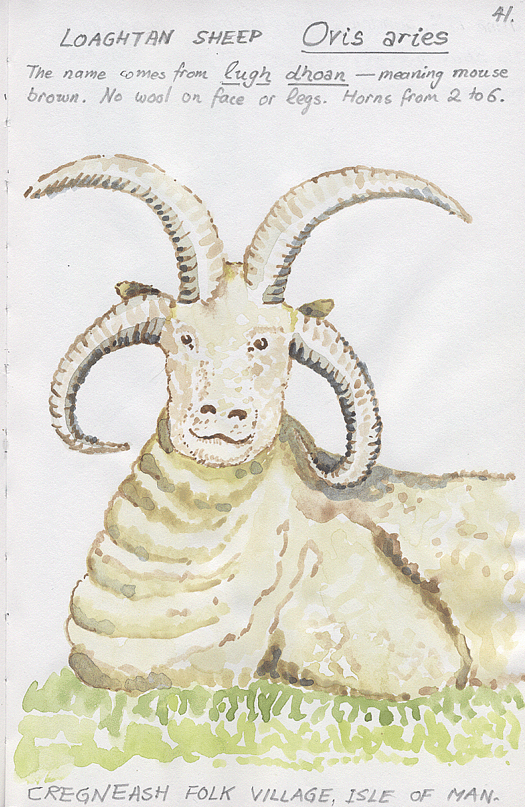
Sheep
were domesticated at an early stage in the transition from nomad to
settled
farmer. Goats probably were domesticated before sheep, but the
domestication of
sheep precedes that of cattle and pigs.
Numerous characteristics have been changed by domestication. Many wild types of sheep have a wool-hair
mixture and, in hot climates, certain species are almost naked. Wool bearing sheep probably were derived
from animals originating in cold or mountain conditions. Domestic sheep
show a
range from very short to very long tails, but all wild types have short
tails. Some sheep deposit fat in their
tails. The lop-eared characteristic is not found in wild sheep and was
produced
very early during domestication. A convex nose is a striking feature of
many
breeds of sheep and is associated with a decrease in length of the
jaws, which
is a common feature in many other domesticated animals such as the pig
and
dog. Wild sheep often wield an array of
elaborately shaped horns. During
domestication the number has been reduced to a single pair, or horns
have been
lost altogether (polled). Animals kept in arid, rocky conditions derive
an
advantage from long legs, while smaller sheep are better for winter
housing in
colder climates.
3.4 Origin of chicken
The domestic
chicken is
descended from the Red Jungle Fowl, Gallus gallus.
Chicken is
used as a generic term in some countries whereas, in others, chickens
are
categorised by age and type. In France, for example, the age range is
from
young poussin to the poule, an old fowl. Similarly, in North America,
although
different breeds usually become anonymous after slaughter, a series of
carcass
types is defined by age and size.
Rock Cornish are 4 to 5 weeks of age, their
carcasses weigh less than about
0.8 kg, and they may be males or females.
Broilers or fryers are about 5 to 8 weeks of
age, have carcass weights
from
0.8 to
1.8 kg, and may be males or females.
Roasters are males or females older than 9 weeks with
carcasses over 1.8
kg.
Capons are castrated males over 9 weeks of age and with
carcasses over 1.8
kg. Surgical castration is difficult (because the male gonads
are inside the
body cavity near the kidneys, as described in LAB 4) and has been
replaced by hormonal castration in
most countries.
Chicken carcasses with tender
meat may be identified by their soft, pliable and smooth‑textured skin,
and by
their flexible sternal cartilage. Chickens such as roosters and mature
hens
producing relatively tough meat are identified by their greater age,
coarse
skin, and stiff sternal cartilage. Several features may be used as a
guide to
the age of a chicken. Young birds have unwrinkled combs with sharp
points. In
older birds, the comb becomes wrinkled with blunt points. The plumage
becomes
worn and faded in older birds, unless the birds have just moulted. With
age,
the subcutaneous fat becomes darker and lumped under the main feather
tracts,
and the pelvic bones become less pliable. Old chickens have large scales
which are rough and slightly raised and their oil sac becomes enlarged
and
hardened. Older male chickens develop long spurs.
3.4 Origin of ducks
Study hint. The
scientific names for the species of the wild ducks are for the hunters
and bird-watchers! No need to learn them.
Wild versus domestic ducks. Ducks,
geese and swans are grouped
together in the Order Anseriformes. Ducks comprise the Family Anatidae.
Ducks
are poor walkers but good swimmers, which means their legs are set far
back in
the body and are well muscled. Ducks are hunted extensively for their
meat. The
main types are the surface-feeding ducks such as the wild mallard (Anas
platyrhynchos),
teal and widgeon (Mareca americana);
the diving ducks such as the redhead (Aythya americana),
canvasback (Aythya valisineria) and ring-necked duck (Aythya
collaris); the sea ducks, which seldom provide meat with a
pleasant
taste; stiff-tailed ducks such as the ruddy duck (Oxyura jamaicensis);
and the mergansers, whose meat is seldom palatable.
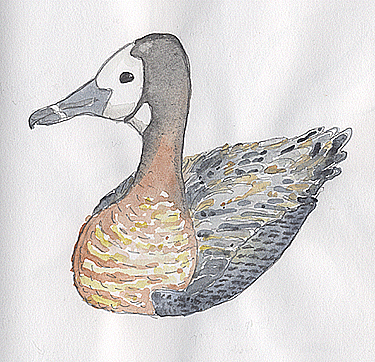
Thus, wild ducks produce meat with a wide range
from delectable to unpalatable. How much of the range is hereditary and
how
much is nutritional? Breed differences in the taste of poultry meat are
slight
to undetectable, so I would join most others in supposing that the
range in
palatability of duck meat is largely nutritional. Thus, the unpopular
taste of
meat from sea ducks and mergansers reflects what the ducks have been
feeding
on. At the other end of the range, the canvasback is rated very highly
for the
taste of its meat, but is instantly disqualified if it has been feeding
on
rotting salmon. Probably one of the key
features of this dietary effect relates to the digestion of fats and
oils in
the bird’s diet. Fats and oils are formed from triglyceride - three
fatty acids
bonded to a glycerol backbone like the three arms of a capital letter
E. As the
triglyceride is digested and moved around the body to be deposited in
the
duck’s own fat, nothing happens to the structure of the fatty acids, they just
get uncoupled and recoupled to a glycerol backbone. Thus, a fatty acid
with an
unpleasant taste from rotting salmon can move, unchanged, from the edge
of the
sea to the edge of your plate (details in LEC 19).
Two types of ducks
have been
domesticated and are extensively farmed, these are worth knowing.
The mallard (Anas platyrhynchos)
and the Muscovy duck (Cairina moschata). The Muscovy may be
identified by its claws (it is able to perch) and a red caruncle or
knob
between the beak and the eyes. Breast meat from female Muscovies may be
tougher, drier and stronger in taste than that from males. The main
changes
produced by domestication have been to increase growth rates and reduce
the
colouration of feathers. Carcass conformation is often not much
different from
a muscular wild duck. Apart from
numerous duck breeds of layers and ornamentals, there are many meat
breeds
around the world. The top ratings
might be the Aylesbury in
England; the Rouen,
Nantes and Barbary in France; and the Long Island in the USA. But this
would
probably be argued by fanciers of other breeds such as the Blue
Swedish,
Crested, Pekin, and Black Cayuga. The muscular Muscovy is the winner if
meat
yield and leanness are the main criteria.
In Canada, ducks
are separated
into a broiler-fryer category, less than 8 weeks of age, weighing 1.8
to 2.8
kg, either males or females; as distinct from the larger roaster, up to
16
weeks of age, either male or female. In Muscovies, the male is larger
than the
female. Youthfulness in ducks is detected by softness of the bill,
sternal
cartilage and trachea.
3.5 Origin of turkeys
History of the word - turkey.
Originally, an English
turkey-cock was a guinea fowl.
Guinea fowl had been
introduced from
Africa and were a paradigm of showiness, as in Shakespeare’s Twelfth
night,
“Contemplation makes a rare turkey-cock of him.” With the exploration
of North
America, the name was applied to the ancestors of the birds we now call
turkeys, Meleagris gallopavo.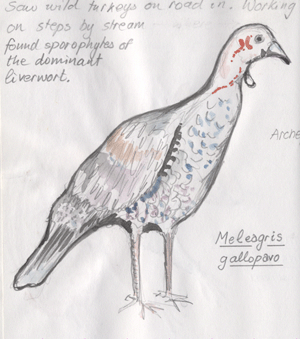
The geographical range of
wild M.
gallopavo is from southern Canada, through the eastern and
southern USA,
down to Mexico. After the Spanish invasion of Mexico, Mexican strains
of M.
gallopavo were introduced into Europe where they were gradually
improved
and assumed the English name of turkey. Thus, when the English and
French
settled farther north in North America, turkeys (M. gallopavo)
were re-introduced as domestic birds which were smaller and more
compact than
their wild ancestors. Agricultural development then restricted the
range of
wild turkeys, although they are now successfully conserved in various
national
parks and protected areas. In the old
days, turkeys were eaten only on special occasions such as Christmas.
But
turkeys are now eaten every day, partly because of the invention of
numerous
processed turkey products, ranging from cooked breast meat slices to
turkey
sausage, and partly because customers have been introduced to a range
of
relatively small turkey cuts.
Further information
J. Clutton-Brock (1987). A Natural
History of Domesticated Mammals. Cambridge University Press, and
British Museum (Natural History). Very scholarly - but easy to
read.
L. Alderson. (1994). The Chance to
Survive. Pilkington Press, Yelvertoft, England.
Super pictures and compulsive reading for anyone who loves farm animals.
Trivia
Bos primigenius.
Water colour of my imaginary butcher's nightmare.
Syncerus caffer.
Water colour from the back of a truck in Kruger Park, South Africa.
Duck. Dendrocygna viduata
on a farm pond in Brazil (local name Marreca-Piadeira).
Melagris gallopavo,
Singhampton, Ontario.





